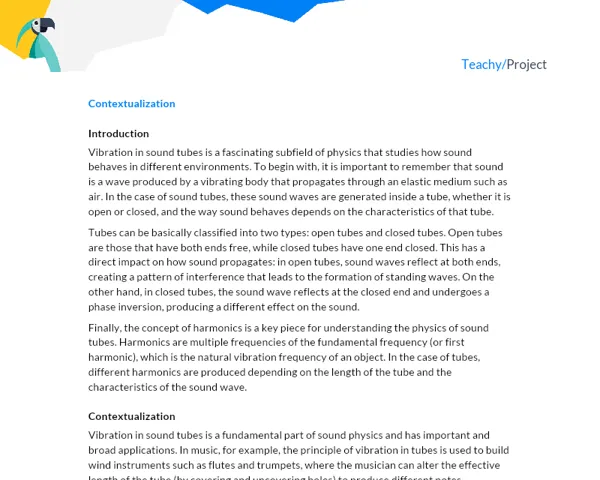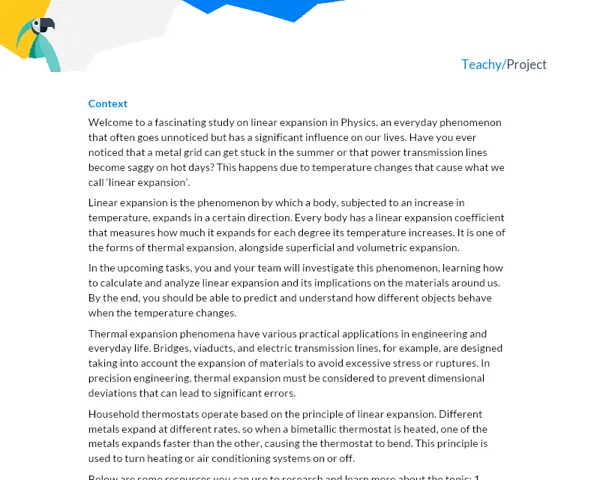Contextualization
Introduction to Buoyancy
Buoyancy is a resulting force exerted by the fluid in which a body is immersed, acting directly vertically and upwards. Buoyancy is characterized by two fundamental properties: the density of the fluid and the volume of liquid displaced by the submerged object. The concept of buoyancy is the basis for understanding a series of natural phenomena and practical applications in the real world, ranging from swimming to the much more complex Archimedes' principle that explains why heavy ships float.
Archimedes' principle states that every body immersed in a fluid experiences an upward vertical force equal to the weight of the fluid displaced by the body. In other words, buoyancy is equal to the weight of the fluid that the body displaced when immersed. Through this concept, it is possible to understand the dynamics of submerged and floating bodies, which has applications in various areas of science and engineering.
Buoyancy is also of vital importance in understanding the forces acting on the movement of bodies in fluid media, both liquids and gases. This includes fundamental concepts for aviation and swimming, for example. Understanding how buoyancy acts in different circumstances can help explain why things float or sink, and why an airplane can take off.
Importance of Buoyancy
The notion of buoyancy is essential in the construction and design of ships, submarines, balloons, airplanes, and rockets. Buoyancy determines whether an object will float or sink in a liquid, or whether an airplane or rocket will be able to take off. In engineering, the principle of buoyancy is used to design structures that need to float or fly. In civil engineering, buoyancy plays an essential role in the design of floating bridges.
Furthermore, buoyancy is also of great importance for marine life. Fish and other marine animals use the principle of buoyancy to move in water, modifying their body density through the ingestion or excretion of gases in their swim bladders.
Practical Activity
Title: "Understanding Buoyancy: Water, Oil, and Balloon"
Project Objective
The objective of this practical project is to explore the concept of buoyancy, Archimedes' principle, and the flotation of materials of different densities in a fluid. Groups of 3 to 5 students will conduct experiments, analyze results, calculate buoyancy, and draw conclusions. Each student should dedicate between five to ten hours to this work over a month.
Detailed Project Description
Students will conduct an experiment where they will immerse a balloon, filled with water, oil, and air, in a container with water. The goal is to observe whether the balloon floats or sinks and relate the result to the density of the fluid in the balloon and the buoyancy exerted on it.
Required Materials
- 3 Balloons
- Water
- Vegetable oil
- Scale
- Container large enough to immerse the balloon
- Tape measure or ruler
Step by Step
-
Step 1: Fill a balloon with water, tie it securely, and measure its mass using the scale. Record the measurement.
-
Step 2: Fill a second balloon with oil, tie it securely, and measure its mass. Record the measurement.
-
Step 3: Fill a third balloon with air, tie it securely, and measure its mass. Record the measurement.
-
Step 4: In a container with water, individually immerse each balloon and observe if they sink, float, or remain suspended in the water. Record the observations.
-
Step 5: Following Archimedes' principle, calculate the buoyancy that the water exerts on each balloon. To do this, it is necessary to calculate the volume of each balloon and multiply this value by the density of water (approximately 1000 kg/m³) and by the acceleration of gravity (approximately 9.8 m/s²). Record the results.
-
Step 6: Analyze the results and make a correlation between the density of the fluid in the balloon, the mass of the balloon, its volume, and the buoyancy acting on it.
Project Deliverables
Based on the step-by-step above, students will produce a report containing the following topics:
-
Introduction: In this section, the group should provide a contextualization of the theme, briefly describing the concept of buoyancy and the relevance of Archimedes' principle in the real world. The group should clearly present the project's objective.
-
Development: Here, students should describe each step of the project, explaining in detail the methodology that was followed. Then, students should discuss the results of the experiment and explain how these results are related to Archimedes' principle.
-
Conclusion: This section should summarize the main points of the project, mentioning the main learnings acquired and the conclusions drawn from the project.
-
Bibliography: References used for the project such as books, web pages, videos, etc. should be listed in this section.
This project, besides solidifying knowledge about buoyancy, also aims to develop other skills in students such as time management, teamwork, problem-solving, critical and creative thinking, among others.


